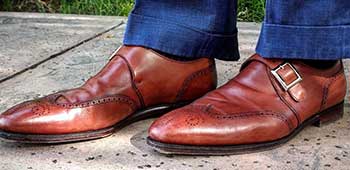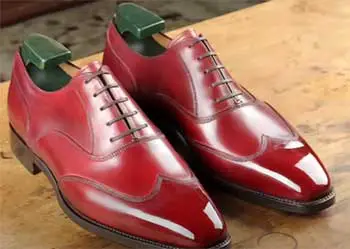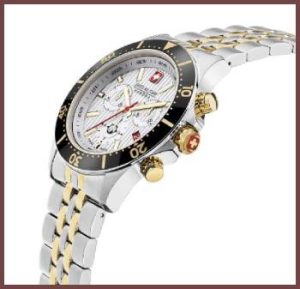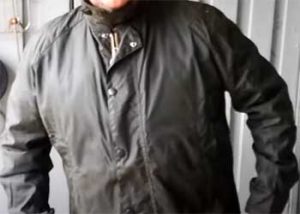When it comes to men’s dress shoes, few brands can compete with the luxury and craftsmanship offered by J.FitzPatrick and Carmina. These two Spanish shoemakers have been producing exquisite footwear for over a century, becoming staples in the world of high-end menswear.
But with price tags starting in the $400-500 range, investing in shoes from J.FitzPatrick or Carmina is no small purchase. You’ll want to make sure you select the brand that offers the right fit, style, and construction for your needs.
That’s why we’ve put together this in-depth comparison of J.FitzPatrick and Carmina – analyzing the key factors that distinguish these two premier brands. Read on for a breakdown of their history, manufacturing, sizing, styles, pricing, and more.
A Brief Comparison Table
| Factor | J.FitzPatrick | Carmina |
| Year Founded | 1866 | 1866 |
| Country of Origin | England/Spain | Spain |
| Construction Style | English hand-lasted | Hand-lasted |
| Leather Origin | Italy | France, Italy |
| Sole Material | Leather/Rubber | Leather/Rubber |
| Widths | Medium/Standard | Medium/Standard |
| Size Range | 7-12 | 6-12 |
| Main Shoe Styles | Oxfords, derbies, loafers | Oxfords, derbies, boots, loafers, monk straps |
| Average Price Range | $400-$600 | $400-$600 |
Also Read: Comparison of Clarks And Hush Puppies Shoes.
Construction and Materials – Evaluating Quality
A men’s dress shoe needs to check all the boxes: elegant style, luxurious leathers, and precision construction that makes the shoes feel like a natural extension of your feet.
Both J.FitzPatrick and Carmina are renowned for their meticulous, detail-oriented manufacturing processes that balance timeless techniques with modern innovations. But side-by-side, there are some notable differences in their construction and materials that impact quality and durability.
- Leather Selection

The quality of leather has a huge impact on the suppleness, strength, and long-term wearability of a shoe.
J.FitzPatrick sources its calfskin leather primarily from Italy, known for producing some of the finest calfskins in hues that patinate beautifully.
Carmina also utilizes supple calfskin from Italy and France.
The company is especially renowned for its sleek wholecut designs created from a single piece of uninterrupted leather.
This allows for a seamless look, but requires exceptional skill to last and stitch the shoes without any vamp or quarters.
Both companies use leather sparingly, reducing waste by creatively utilizing every last scrap. The tanning and finishing processes emphasize preserving the natural beauty and feel of the hides.
For exotic leathers, J.FitzPatrick crafts a specialty crocodile skin line. Carmina offers shagreen shells cordovan leather options. Bottom line – the leather selection you find from both brands will be top-tier.
- Hand-Lasting and Stitching Techniques
True dress shoes should mold perfectly to your feet. That’s why J.FitzPatrick and Carmina still rely on meticulous hand-lasting to shape each shoe.
J.FitzPatrick is especially known for its elegant English hand-lasted construction:
- The last shape is longer and narrower with a lifted toe spring
- Leather sock linings mold to the foot’s shape
- Leather insoles further prevent sliding
Carmina’s renowned Forest last also provides an anatomical fit. However, with rounder toes and wider waists, it offers a bit more room than J.FitzPatrick’s tapered lasts while still maintaining a refined, versatile silhouette.
In terms of stitching methods, both companies offer Goodyear welted and Blake stitched options:
- Goodyear welted shoes have the upper stitched to the welt, which is then stitched to the sole. This creates an elegant seam “rim” around the edge.
- Blake stitched shoes have the upper stitched directly to the sole, creating a flexible, lightweight feel.
The price goes up for Goodyear welted shoes, but they can be resoled, whereas Blake stitched soles eventually require replacing the whole shoe once worn down.
- Soles and Finishing

The majority of soles from both shoemakers are leather.
J.FitzPatrick also offers a hand-welted line with anti-slip rubber soles that are sleek and unobtrusive.
Carmina has a wider selection of rubber-soled options for casual wear.
The finishing touches also display incredible attention to detail. Shoes are polished with multiple fine layers of wax and stain to achieve a subtle luster. Edges are meticulously burnished and finished. Heels are hand-painted. No shortcuts are taken.
When comparing the manufacturing and construction methods, J.FitzPatrick leans slightly more traditional and formal, while Carmina offers greater variety. But both represent the pinnacle of handcrafted quality and comfort.
Sizing and Fit – Achieving that “Custom” Feel
An ill-fitting dress shoe can quickly ruin the look of an otherwise sharp outfit. When investing $500+ in luxury footwear, you need a perfect fit. Here’s how J.FitzPatrick and Carmina compare when it comes to sizing:
In terms of widths, both brands cater to medium/standard feet. Their elegant lasts are not made for wide sizes. J.FitzPatrick only offers full-sizes starting at a UK 7, while Carmina starts at UK 6 for more options.
The last shapes and general fits differ in a few key ways:
J.FitzPatrick

- Elegant, elongated last
- Slimmer in the heel and waist
- Toe shape is more tapered
- Overall sleeker, narrower profile
Carmina
- Rounder toe box
- Wider in the waist and ball of foot
- Heel cup is slightly wider
- Overall more spacious forefoot
For most men, sizing between the two brands will align pretty closely. However, the lasts do fit somewhat differently. So be sure to carefully measure your feet and consider having both sizes shipped to determine the best fit.
Also keep in mind that J.FitzPatrick and Carmina shoes will mold to your feet over time, with a relatively quick break-in period. The right fit should feel snug at first, with the uppers softening and conforming over several wears. The result will be a personalized, almost bespoke feel.
Also Read: Differences Between Florsheim And Rockport Shoes.
Range of Men’s Shoe Styles
Beyond fit and construction, the variety of shoe styles and designs is another important differentiator between the shoemakers.
J.FitzPatrick Styles
The J.FitzPatrick aesthetic skews towards more formal, refined dress shoes with timeless silhouettes. The brand has become synonymous with handcrafted Oxfords featuring elegant broguing and medallion details across different toe shapes:
- Cap toe Oxfords – The iconic dress shoe, with the sleek upper accentuated by the cap toe. J.FitzPatrick’s hand-lasted Oxfords are dressy yet understated.
- Wholecut designs – Striking and sharp, made from a single piece of fine leather. A challenging style to make requiring premium skins.
- Plain toe variations – Exude simplicity and versatility. Less ornamentation highlights the clean lines.
In addition to Oxfords, J.FitzPatrick also produces fine Chelsea boots, chukkas, derby shoes, slip-on loafers, and minimalist sneakers. Overall the focus is on traditional, aristocratic styles with attention to nuances like patina development.
Carmina Styles
Carmina also offers premium Oxford, loafer, boot, and dress shoe selections. However, the brand has a wider range of more casual, fashion-forward styles compared to J.FitzPatrick’s formal designs:

- Brogue derby shoes – Rugged and decorative with pinked/perforated details.
- Two-tone spectator shoes – Striking contrast colors for a bold statement.
- Monk straps – Classic without laces, using a buckled strap closure.
- Chelsea boots – The versatile ankle boot worn formally or casually.
- Jodhpurs – Eye-catching boot with straps and elastic goring.
Carmina is willing to experiment more with trending or contemporary styles while still upholding impeccable craftsmanship. Their collections feature unique touches like suedes, exotic leathers, and one-of-a-kind patinas.
The bottom line: J.FitzPatrick offers a core selection of perfected dress staples. Carmina provides more variety for personal style, from boardroom to weekend.
Pricing – Worth the Investment
The next major difference that shoppers evaluate when choosing between J.FitzPatrick and Carmina is the pricing. What you get for your money reflects both brands’ commitment to quality.
J.FitzPatrick’s shoes start around $450 for basic leather Oxfords or derbies. Prices quickly go up from there for detailed broguing or hand-welting, reaching $700+ for exotic skins like crocodile. The brand rarely offers discounts or sales.
Carmina’s standard retail prices fall very close to J.FitzPatrick’s, ranging from $450 up to $800+ depending on leather choice and construction. Carmina does offer some periodic sales taking 15-25% off certain styles.
Considering these shoes are built from the finest materials and crafted to last decades, the pricing is quite fair and competitive. The upper echelon of luxury shoemaking starts at $1000+ per pair.
While never cheap, both J.FitzPatrick and Carmina provide outstanding comfort, support, and enduring wearability that helps justify costs. With proper care and maintenance, you’re making an investment that repays itself through years of daily wear.
J.FitzPatrick Vs. Carmina: Key Takeaways
- Handcrafted quality and tradition since 1866
- Meticulous construction from the finest materials
- Retail around $400-600 per pair
- Carmina offers more casual/contemporary options
- J.FitzPatrick focuses on timeless elegant styles
- Both deliver an exquisite personalized fit
- Shoes built to last decades when cared for
At the end of the day, men seeking out benchmade footwear can’t go wrong with either shoemaker. While J.FitzPatrick and Carmina have their unique strengths and aesthetics, they both represent the pinnacle of luxury craftsmanship.
Also Read: Comparison of Carmina And Allen Edmonds Shoes.
Frequently Asked Questions (FAQ)
Beckett Simonon has made a name for itself producing Blake stitched leather shoes with sleek designs at prices around $200. While the quality is decent for the price, they lack the elite construction and materials of J.FitzPatrick and Carmina. You get what you pay for.
For all-day comfort right out of the box, you can’t beat hand-lasted dress shoes like those from J.FitzPatrick and Carmina. The anatomical lasts and expert molding to the foot create a “custom” feel. Alden and Allen Edmonds also produce excellent comfortable dress shoes.
It depends on the loafer. Sleek designs from J.FitzPatrick and Carmina work well with modern tailored suits in casual offices. Beefroll penny loafers can also look sharp. But clunky chunky styles should be avoided for formal business suits.
With proper rotational wearing and occasional repairs, you can expect 20+ years of wear from brands like J.FitzPatrick and Carmina. Well-constructed Goodyear welted shoes that are resoleable essentially last a lifetime.
In Conclusion: Legacy Brands Delivering Timeless Luxury
J.FitzPatrick and Carmina have endured over 150 years by staying dedicated to their heritage while continuing to refine their craft. That dedication translates directly into the tangible quality and comfort found in their shoes.
These two Spanish luxury brands have earned their reputations as premier men’s shoemakers by never compromising on materials, construction, or design. Their benchmark craftsmanship simply can’t be replicated at lower price points.
Discerning buyers invest in J.FitzPatrick and Carmina because they appreciate owning footwear that provides enduring value and aging gracefully. While not inexpensive, their shoes deliver comfort and style that lasts decade after decade.
So for shoppers seeking out luxury men’s dress shoes, rest assured you’ll be stepping into comfort and panache with either J.FitzPatrick or Carmina gracing your feet. Just be sure to budget accordingly, because their masterful creations are well worth the splurge.



